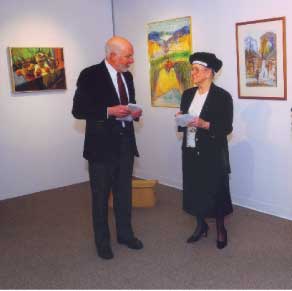When Deb Sim took over as director of the Armory Art Gallery in the summer of 2003, she panicked when she realized she needed to fill a slot in the gallery show schedule for the coming year. Then somebody told her to go to Henderson Hall and check out the Miles and Ruth Horton Collection that Ruth had recently donated to the university. "I thought it would be neat to do a show" and have a small reception for Ruth Horton at the opening, Sim says. She went to Henderson and was stunned when she found two rooms filled from floor to ceiling with boxes loaded with more than 700 pieces of art. "I've got hooked rugs. I have kid art. I've got African carvings, South American textiles, everything," Sim says. "It was daunting. ... It's a fascinating accumulation."
"They [Tech] are expanding in the humanities and they do not have that much art on campus, and I hoped this would be a nucleus to be added to and a teaching tool," says Ruth, who wants her example to inspire others. "You can't learn about art if you don't see it and if you haven't studied it." Both Distler and Sim describe the collection as "eclectic," largely because the couple bought what they liked, not for prestige or because they thought a piece would be valuable in the future. "It's about their life," Sim says. "It's about their love of the area. It's about their love of art. It's a very touching thing." According to Distler, the collection is particularly strong in three areas: artists of Southwest Virginia, including Joanie Pienkowski, Maryann Harman, Dean Carter, Frank Hobbs, and Walt Hewes; African art; and American primitive painters. It also includes work by some nationally known artists, such as Howard Finster and Ida Kohlmeyer. The Hortons first came to Blacksburg in 1956 when Miles was hired as Tech's head reference librarian. Independently wealthy, he retired in the early 1960s and the couple moved onto Salt Pond Mountain in 1964, where they started building their house, called Nightmare Abbey, and the studio, called Headlong Hall, named from stories by early-19th-century author Thomas Love Peacock. Although Ruth jokes that Miles--who friends sometimes called "Sir Miles of Giles"--built the studio "to get away from me" when they were still living in a small cabin, the studio was often used for workshops or to give artists a place to stay and work. When the Hortons donated the studio to Tech in the 1980s, retired art professor Ray Kass started conducting the Mountain Lake Workshops, which brought in internationally known artists to work with students, artists, and interested residents. "One of Miles' avocations was painting. He loved to dabble in painting," Ruth says. "He had many talents, but he didn't stick with anything for any great length of time." One exception was biology, which led him to build the research center named in honor of his father. This passion was sparked in part by a former teacher named Flossie Martin, who showed him the vorticella, a microscopic creature. Over the years, Miles commissioned local artists to create their own interpretations of the vorticella, and he named numerous things, such as the Martin Observatory and the Flossie Martin Art Gallery at Radford University, after his teacher. Both Hortons became known for their promotion of anything cultural. Distler's first contact with them came shortly after he arrived at Tech in 1967. Miles called to tell him there was a book club to stimulate culture and to ask if Distler could come and discuss a play with the group. Miller first met the Hortons as an architecture student when Miles brought students to his house for a slide show. The Hortons subsidized visiting professors at the University of Virginia biological station at Mountain Lake and supported local research to bring back the American chestnut. Ruth was the driving force behind the "Artstravaganza" auction that for five years raised scholarship money for art students. The couple also supported local artists and the people, such as Miller, who sold art. Ruth remembers traveling the world looking for good African art at a reasonable price, only to return empty-handed. "But I found it in Blacksburg. I walked into Miller Off Main Street and there it was," she says. For now, the art remains in Henderson as it's being catalogued and appraised. Some of Walt Hewes' Giles County paintings and similar works will be hung in the new alumni center and at Hotel Roanoke, and others will be used as a resource for students, just as Ruth Horton envisions. "I think this is an amazing step for Tech and I think it was a risk," says Sim. "It was a leap of faith for her and for Tech. ... It says we're interested in art, not just posters of the Drillfield." Richard Lovegrove is an editor in University Relations. |
